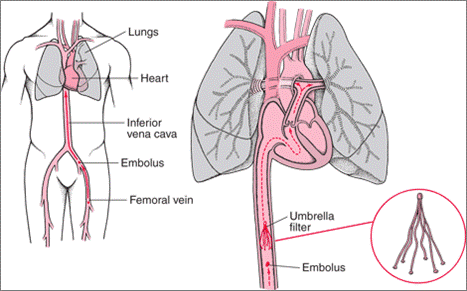Design team members: Chen Liu, Valerie Gerum
Supervisors: Dr. Maud Gorbet
Background
Blood clots are more likely to form in some people than others. If a person is prone to clotting, and unable to be put on anti-clotting medication, they may be at risk for pulmonary embolism - a blockage of an artery of the lung by a blood clot. Pulmonary embolism (PE) is extremely painful and can be deadly. Watch a cool video demonstrating the cause of PE!
In order to prevent PE, an inferior vena cava filter can be used to trap blood clots before they can reach the lungs. (See Figure 1) An inferior vena cava filter is a small medical device usually made of titanium, stainless steel, or other metal alloys. It is installed inside the inferior vena cava between the lower body and the heart.

The bad news is: clinical evidence shows that permanent IVC filters may lead to a number of complications, some of which are lethal themselves. The main cause of the complications may be the build-up of blood clot within the filter over time, which inevitably occurs because an IVC filter is not designed to break down a trapped blood clot.
Project description
The objective of this project is to design a means of destroying a blood clot once it is trapped in an IVC filter. It has been decided to use a biochemical agent that will promote the dissolving of the trapped blood clot. Tissue plasminogen activator (tPA) has been chosen for this task, as is an effective enzyme for digesting the fibrin, which holds a blood clot together.
Biocompatible polymers will be used to make drug-delivering containers that open when a blood clot is detected in the filter, releasing the tPA within. Once the clot has been dissolved, the polymer containers will close to stop the release of drug. This mechanism will need to be repeatable, as the IVC filter may trap many blood clots while inside the body.
Design methodology
The design methodology can be summarized as follows in Figure 2.

Figure 2 – Summary of Design Methodology
Background research is conducted first to identify current area of improvement in the permanent IVC filter treatment. High-level user requirements and constraints are generated. They are used to derive quantifiable low-level design requirements. Those requirements will be the inputs to the design phase, where a number of concepts will be brainstormed. The best concept will be chosen based on the user requirements and computational modeling results. Detailed design process will follow and a prototype will be built. Finally, validation process is used to test the design against the requirements. Iteration may be performed until design reaches acceptable performance.